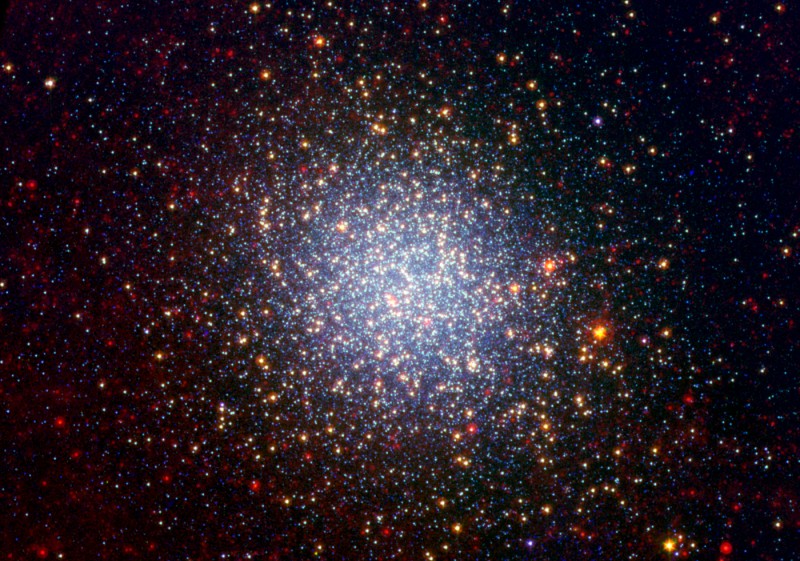오메가 센타우리 구상성단은 지구로부터 1만 5천광년 떨어져 있으며 그 지름은 150광년에 달한다.이 구상성단은 우리은하의 후광에 포함되어 있는 200여개의 성단중 가장 거대한 성단으로서 무려 1천만개에 달하는 별들이 포함되어 있다.
이 사진은 가시광선 대역에서 촬영된 사진과 스피처 우주망원경으로부터 얻은 적외선 사진을 합성한 것으로 푸른색 색조를 띈 것이 가시광선 대역에서 얻어진 것이다.
스피처가 촬영한 부분에는 두 가지의 적외선 대역이 포함되어 있는데 그 중 하나는 초록색으로 다른 하나는 붉은색으로 표현되어 있다.두가지 적외선 대역 모두 온도가 낮은 거대한 규모의 별로부터 발생한 빛을 포착하고 있다.
이 사진에서 노란색 점들로 표현되고 있는 것이 모두 거대한 별들로서 적외선 사진이 촬영한 붉은색과 초록색이 합쳐져서 만들어낸 색이다.
물론 붉은 점들 역시 차갑고 거대한 별들을 표현하기는 하지만 몇몇 붉은 점들은 훨씬 뒤쪽에 멀리 존재하는 은하들을 나타내기도 하고, 단순히 적색 거성을 나타내기도 하는데 적색거성은 우리의 태양이 진화를 거듭하여 50억년 후에 도달하게 될 별들의 생명주기에서 마지막 단계의 별을 말한다.
차갑고 거대한 별의 대기속에 포함된 먼지덩어리들은 궁극적으로는 새로운 별과 행성을 형성하는데 사용될 것이다.
정보출처 : NASA - 오늘의 천체사진(2008년 5월 1일 자)
http://antwrp.gsfc.nasa.gov/apod/ap080501.html
참고 : 켄타우루스자리 오메가 구상성단을 비롯한 각종 성단에 대한 포스팅은 하기 링크 INDEX를 통해 조회할 수 있습니다.
https://big-crunch.tistory.com/12346975
원문>
The Giants of Omega Centauri
Credit:
,
, Martha Boyer (
),
.
Explanation: Globular star cluster Omega Centauri is some 15,000 light-years away and 150 light-years in diameter. Packed with about 10 million stars, Omega Cen is the largest of 200 or so known globular clusters that roam the halo of our Milky Way galaxy. This intriguing color picture combines a visible light image of the cluster in blue hues with infrared image data from the Spitzer Space Telescope. The Spitzer data includes images in two infrared bands, one shown in green and one in red. Both infrared bands are sensitive to light from the cool, giant stars in the cluster. Adding the red and green colors together creates yellow, showing off the cluster's giant stars as yellow spots. Of course, red spots also indicate cool, giant stars in the image, but some of the red spots are even more distant background galaxies. Also known simply as Red Giant Stars, they represent a stage in the life-cycle of stars more evolved than our own Sun, a stage the Sun will reach in about 5 billion years. Dust grains formed in the atmospheres of cool, giant stars are ultimately involved in the formation of other stars and planets.
'3. 천문뉴스 > NASA 오늘의 천체사진' 카테고리의 다른 글
| 남극의 개기일시 (0) | 2008.05.04 |
|---|---|
| NGC 6188 (0) | 2008.05.03 |
| Arp 272 (0) | 2008.05.03 |
| NGC 3582 (0) | 2008.04.28 |
| 은하중심의 라디오파 아치 (0) | 2008.04.27 |
